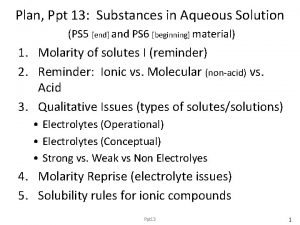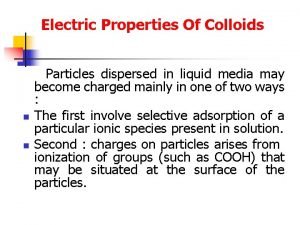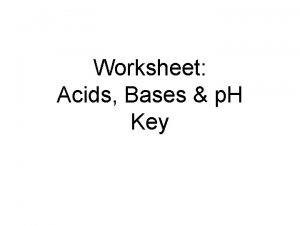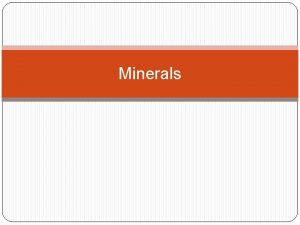electrolytes Electrolytes are electrically charged minerals v that





















- Slides: 21

electrolytes

Electrolytes are electrically charged minerals v that help move nutrients into and wastes out of the body’s cells. v maintain a healthy water balance and help stabilize the body’s acid level. Ø

v Electrolytes Calcium o Chloride o Magnesium o Phosphorous o Potassium o Sodium o profile include:

v How is it used? Used to detect hypo- or hyper- in electrolytes associated with dehydration, edema, and a variety of diseases. v Your doctor may order this test, along with other electrolytes, to screen for an electrolyte imbalance. v

v How the Test is Performed? Ask the patient if he takes any drugs. v Obtain a 5 ml venous blood sample. v Heparin blood can be used (green tube). v Avoid hemolysis. v Observe standard precaution. v You should not eat or drink for at least 6 hours before the test. v

Na (Sodium ): v Sodium is a positively charged molecule that works with other electrolytes. Important for: v Distribution of water between extracellular v and intracellular fluid. v Nerve impulses v Heart muscle contractibility

q v v v Sodium test: : Blood sodium testing is used to detect abnormal concentrations of sodium, termed hyponatremia (low sodium) and hypernatremia (high sodium) acid base balance Water intoxication and dehydration. Normal range: 136 -145 mmol/L

Ø For greater than normal sodium levels (hypernatremia) associated with the following condition: 1. . diabetes insipidus 2. . hyperaldosteronism. . cushing syndrome Dehydration and insufficient water intake. 3. 4. Ø 1. 2. 3. 4. For lower than normal sodium levels (hyponatremia) associated with the following condition: Excessive fluid loss (diarrhea, vomiting, sweating ) Addison disease (impair sodium reabsorption) Drugs such as diuretics hypothyroidism

Potassium (K) test: ü A potassium test checks how much potassium is in the blood , diagnoses acid base and water imbalance. Ø Important ü ü ü q for: keep the water (the amount of fluid inside and outside the body's cells) electrolyte balance of the body. Potassium is also important in how nerves and muscles work. Normal range: 3. 5 -5. 1 mmol/L

Ø ü ü ü High levels of potassium (hyperkalemia) may be due to: kidney failure Certain medications Red blood cell destruction Too much potassium in your diet. Low levels of potassium (hypokalemia) may be due to: Not enough potassium in the diet. Diarrhea , vomiting , sweating. Malabsorption and starvation.

q. Calcium: Calcium helps build strong bones and teeth. It is important for heart function , muscle contraction, nerve signaling, and blood clotting…. q Calcium test: A blood calcium test is measures the concentration of both total and ionized calcium in blood. To diagnose a range of conditions relating to the bones, heart, nerves, kidneys, and teeth.

Ø Normal range(ca+2): Children: 4. 4 - 6. 0 r (mg/d. L) Adults: 4. 4 - 5. 3 mg/d. L Ø Normal values range (ca) : 8. 5 to 10. 2 mg/d. L.

Ø Higher-than-normal levels of ionized calcium may be due to: Tumors Vitamin D Excess hyperparathyroidism Lack of mobility Ø Lower-than-normal levels may be due to: Hypoparathyroidism Malabsorption Renal failure Rickets Vitamin D deficiency

Ø magnesium (mg) test A serum magnesium test is a measurement of how much magnesium there is in the blood. Ø Important for: It helps maintain normal muscle and nerve function, keeps the bones strong controls the heart beat, helps regulate blood pressure. controls blood sugar levels and helps support the body's defense (immune) system. Normal Results 1. 7 to 2. 2 mg/d. L q

Ø High magnesium levels may be due to: Addison's disease Chronic renal failure Dehydration Diabetic acidosis Ø Low magnesium levels may be due to: Alcoholism Hemodialysis Pancreatitis Too much insulin

Chloride (cl)test: A chloride test measures the level of chloride in your blood or urine. Ø Important for: It helps keep the amount of fluid inside and outside of your cells in balance. It also helps maintain proper blood volume, blood pressure, and p. H of your body fluids. Ø Normal Results 96 - 106 m. Eq/L. Ø

Higher level of chloride (hyperchloremia). may be due to: Carbonic anhydrase inhibitors (used to treat glaucoma) Metabolic acidosis Respiratory alkalosis Renal tubular acidosis lower- level of chloride (hypochloremia). may be due to: Addison's disease Dehydration Gastric suction Respiratory acidosis

Ø o o Phosphorus test: Phosphorus is a mineral that combines with other substances to form organic and inorganic phosphate compounds. Important for: Phosphates are vital for energy production, muscle and nerve function, and bone growth. play an important role as a buffer, helping to maintain the body's acid-base balance. Normal Results 2. 4 - 4. 1 mg/d. L Ø

Ø Higher than normal levels (hyperphosphatemia) may indicate: Diabetic ketoacidosis Hypocalcemia Liver disease Too much vitamin D Ø Lower than normal levels (hypophosphatemia) may indicate: Hypercalcemia Malnutrition Too little dietary intake of phosphate or vitamin D

Reference: http: //www. nlm. nih. gov/medlineplus/ency/article/003481. htm http: //labtestsonline. org/understanding/analytes/calcium/tab/test http: //www. nlm. nih. gov/medlineplus/ency/article/002350. htm http: // www. umm. edu • Understanding Laboratory & Diagnostic Tests Book Publisher: Delmar Cengage Learning; 1 edition (September 23 , 1997)

y: b e n Do eido n a n Ha 272 led 4 7 8 0 lmow a h a Rand 74140 08
 Mikael ferm
Mikael ferm Con hãy đưa tay khi thấy người vấp ngã
Con hãy đưa tay khi thấy người vấp ngã Thơ thất ngôn tứ tuyệt đường luật
Thơ thất ngôn tứ tuyệt đường luật Tôn thất thuyết là ai
Tôn thất thuyết là ai Phân độ lown ngoại tâm thu
Phân độ lown ngoại tâm thu Walmart thất bại ở nhật
Walmart thất bại ở nhật Gây tê cơ vuông thắt lưng
Gây tê cơ vuông thắt lưng Block nhĩ thất độ 2 mobitz 2
Block nhĩ thất độ 2 mobitz 2 Tìm độ lớn thật của tam giác abc
Tìm độ lớn thật của tam giác abc Sau thất bại ở hồ điển triệt
Sau thất bại ở hồ điển triệt Thể thơ truyền thống
Thể thơ truyền thống Tropolar
Tropolar Strong vs weak electrolytes
Strong vs weak electrolytes Chapter 25 fluid electrolyte and acid-base balance
Chapter 25 fluid electrolyte and acid-base balance Vapor pressure lowering
Vapor pressure lowering Herbalife 24 line
Herbalife 24 line Effect of electrolytes on chemical equilibria
Effect of electrolytes on chemical equilibria Weak electrolytes examples
Weak electrolytes examples Protective colloids
Protective colloids Strong vs weak electrolytes
Strong vs weak electrolytes Major intra and extracellular electrolytes
Major intra and extracellular electrolytes Vacid meaning
Vacid meaning









































